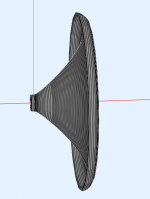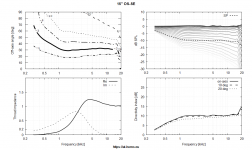Glad the software can continue!
Lets see if I can do a 3d model of some of my corner horn ideas.
Lets see if I can do a 3d model of some of my corner horn ideas.
What I have in mind is something like this sketch (if it attached). A shallow rectangular-ish box with the tweeter in one corner and a MEH style woofer. The tweeter needs to be flush with the corner. If we choose the direction it is facing as 0 degrees then the HF horizontal polars should approximate a tweeter twice as long and high (with the walls removed).
Tweeter = horn loaded comp. driver or dome tweeter?
I've seen several (double) bass arrays, but these are often integrated in the front (and rear) walls, thus approaching a wall of sound > coherent wavefront.
By frontloading woofers and tweeters, DI can be controlled, at least from the lower midrange/upper bass, depending on the size of the mouth.
An AMT would be the first choice but it might need to be DIY in order to be compact enough while covering enough octaves. I'll probably buy 19mm domes for experimentation but, truth be told, the first version that I set up in my living room will likely use some 2" Peerless drivers from a Pluto style build - along with felt/foam on the walls to shade the reflected highs.
AllenB, you're right about the highs in that test setup. The planar driver is from a pair of Fostex headphones and is about 35-40 mm. The HF was uniform to about 4 kHz. For something crammed into the top of bottom corners of a room, that might be good enough but could surely be improved. Finding out whether the sound stage is tolerable with speakers in those locations is another thing to check.
In the past I made some 40 cm paper mache axisymmetric OS waveguides for testing. My grand plan is to use these as a benchmark when trying something different.
AllenB, you're right about the highs in that test setup. The planar driver is from a pair of Fostex headphones and is about 35-40 mm. The HF was uniform to about 4 kHz. For something crammed into the top of bottom corners of a room, that might be good enough but could surely be improved. Finding out whether the sound stage is tolerable with speakers in those locations is another thing to check.
In the past I made some 40 cm paper mache axisymmetric OS waveguides for testing. My grand plan is to use these as a benchmark when trying something different.
Working on Ath 4.7.0, I've finally put together a document summarizing the OS-SE waveguide formula: OS-SE Waveguide.pdf
I believe that with the OS-SE formula it's now possible to approximate almost anything - it is a "generalized OS".
I believe they can be very well approximated but I haven't tried though as I'm not really much interested in the other curves. I judge based on the throat impedance curves where there's possible to get almost anything with the OS-SE only. Is that "no"? Take it as no if you wish.
to bad...
i just can't figure out how to get an oblate spheriod to work at frequencies lower then 1khz and what it does above that leaves a lot to be desired...i know that's expressing a personal opinion but i just can understand why people think these things sound good.
i just can't figure out how to get an oblate spheriod to work at frequencies lower then 1khz and what it does above that leaves a lot to be desired...i know that's expressing a personal opinion but i just can understand why people think these things sound good.
You were interested in what Ath does, correct? It simulates horns (generates the geometries, to be precise).
Not to mention that there are already many confirmations that the sims are very close to the real things.
Not to mention that there are already many confirmations that the sims are very close to the real things.
ok thanks and don't think that i'm in any way slighting you or your work.
but in my time using one of the only pro products that i know of that's based on an oblate spheriod i've encountered sonic anomalies that i've tried to gain an understanding of.
but in my time using one of the only pro products that i know of that's based on an oblate spheriod i've encountered sonic anomalies that i've tried to gain an understanding of.
Last edited:
Well I think that by now we very well understand the anomalies in OS waveguides and also know how to overcome them. There's really nothing wrong with the OS per se and it can sound extremely good.
But let's also add that a pure OS waveguide doesn't exist. It would have to be inifinite. So when you are talking about "OS waveguide" you just have to be aware of that you're always talking also about something else - its particular termination.
But let's also add that a pure OS waveguide doesn't exist. It would have to be inifinite. So when you are talking about "OS waveguide" you just have to be aware of that you're always talking also about something else - its particular termination.
Last edited:
what would you say are the well known anomalies of OS waveguides, HOM's? truncating it to a finite horn?
well for me it's both ends if the throat input doesn't see perfectly plane waves or the mouth termination produces diffraction the reflected energy the driver see's is bad news fast.
it is an elegant mathematical solution that has a hard to deal with real world caveat.
it is an elegant mathematical solution that has a hard to deal with real world caveat.
Actually, it seems from the simulations (and measurements seem to confirm) that there's quite a tolerance in the throat wavefront shape, i.e. the impact is not as strong as one would think. I'd say that there's quite a long way from perfect to a point where it goes really bad. At least for compression drivers.
i used to have a pile of DH1A diaphragms that said different.
i'm likely wrong but i've speculated that the curvature of an OS is kind of like a piano string approaching it's proper pitch...you can hear the frequency beats of the harmonics oscillating as it approaches pitch and with the OS any diffraction produces a similar sonic effect.
i'm likely wrong but i've speculated that the curvature of an OS is kind of like a piano string approaching it's proper pitch...you can hear the frequency beats of the harmonics oscillating as it approaches pitch and with the OS any diffraction produces a similar sonic effect.
- Home
- Loudspeakers
- Multi-Way
- Acoustic Horn Design – The Easy Way (Ath4)

